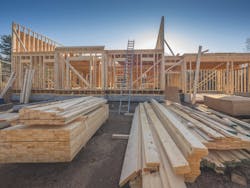No one could have predicted the events of the past year and their impact on businesses and the economy. While many small business owners had to deal with jobsite shutdowns, ongoing labor shortages and increased jobsite safety concerns due to COVID-19, material shortages and delays dealt the largest shock to project costs.
Lumber prices have been especially volatile, surging more than 250 percent in the past year and adding thousands of dollars to a project’s bottom line. NAHB is hard at work, reaching out to the Biden administration and members of Congress urging them to call on domestic lumber producers to ramp up production and, among other steps, make it a priority to work with Canada on a new softwood lumber agreement.
In the meantime, builders and remodelers have learned some important lessons when it comes to estimating amid rising material prices and uncertain times.
Project management and estimation
Vince Butler of Butler Brothers Corporation, a home builder and remodeler from Northern Virginia and a master instructor for NAHB, recently discussed the subject of project management – including estimating during a pandemic – for a Building Knowledge session of the virtual International Builders’ Show, IBSx.
Butler sat down with John Barrows, a Graduate Master Builder, Master Green Professional and founder of P3 Builder Group Inc. in Bridgehampton, N.Y. Both men said the applications of lessons learned this past year can help with future crisis management, noting their best lesson learned was to use an escalation clause.
“NAHB has some recommended clauses and you should put one in your contract, pandemic or no pandemic,” Barrows said. The extreme volatility in framing materials, particularly lumber, is the best illustration of why remodelers need an escalation clause. The clause states that if prices for certain component building materials rise after execution of a contract, the client agrees to pay that cost increase to the builder or remodeler.
“I had avoided escalation clauses for many years, not as a business strategy but as a marketing strategy,” Butler noted. “I was selling a fixed price job and locking in a price for a customer and then sticking to it.” But the pandemic changed Butler’s mind and business practices. “That is the biggest single change in my estimating and budgeting practices. There’s no way that you could prepare for the type of expenses that we incurred or the price increases that we experienced.”
Butler says he continues to be cautious and advises customers that prices cannot be locked in like before. “Having the ability to share that cost increase with the customer is helpful, although I am still reluctant to apply those adjustments if we can find any other means of absorbing the cost,” he says. “Being at the ‘end of the road’ as far as passing on these increases means I have to weigh the effect on client relations against the budget impact.”
Lock in prices by buying materials early on in the process
Equally as important the experts say is “buying out the job” – or ordering everything needed for the job at contract signing – a practice they say makes sense at any time since it helps ensure costs won’t escalate dramatically as a project progresses.
Communicating with the client, suppliers and workers on the jobsite is also critical. “We need to be honest about what is happening on the job,” said Barrows. The workflow from pre-pandemic times has certainly changed; we’re facing a lot more delays. It’s your job to communicate those delays to the client so they are knowledgeable about any difficulties you’re facing.”
Be aware of outside circumstances with your client that may be adding stress. Many are in a changing environment themselves as they navigate working from home with their kids attending school from home as well.
Keeping things on schedule is important to the overall bottom line, but scheduling through uncertainty can also take quite a bit of planning. “Things can change but there is a very good argument for having a schedule. We weren’t shutdown but we had workplace restrictions,” Butler said.
These strategies can help others in the industry face challenges going forward. “It’s difficult to build or remodel a home in the best of times, but now we have to be more flexible. I don’t ever want to promise something that is going to be impossible to deliver,” Butler said.
